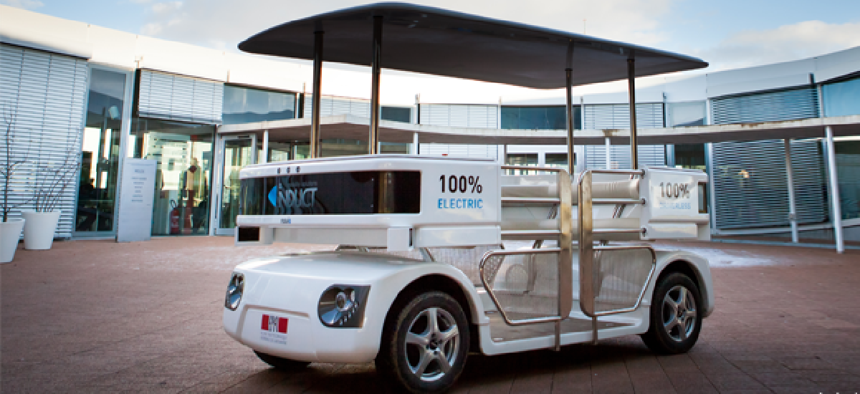Army tests driverless vehicles in 'living lab'

Federal installations and universities are test beds for implementing autonomous vehicles in public environments.
In its search for ways to most effectively employ autonomous vehicles on military bases, a team led by the Army’s Tank Automotive Research, Development and Engineering Center (TARDEC), is putting its primary focus on the process rather than the product.
TARDEC’s Autonomous Robotics for Installation and Base Operations (ARIBO) is a series of pilot programs using federal installations and universities as test beds for developing guidelines for operating autonomous vehicles in public environments.
“One of the challenges in robotics is user acceptance and fully understanding how to implement the technology in a way that realizes its full value,” said Paul Rogers, director of TARDEC. “So ARIBO was based on what we call ‘living laboratories.’ It provides a forum where we can bring the technology into an environment where it actually applies, and the end-user gets to use the technology.”
According to Rogers, the living laboratories are as helpful to the technology developers as they are to users. “Both parties are learning,” he said. “The technology-based people are learning where the technology has its shortcomings and where to increase capabilities, and the end users get to understand how it can change the way they do their work.”
At the same time, ARIBO is not focused on any specific technologies. Instead, the series of pilots will be used to test different vehicles and different sets of sensors employed in different service scenarios.
The first pilot – in which two autonomous shuttles are being used to transport people at Stanford University – launched in April. Pilots are also scheduled for West Point in July and at Fort Bragg in North Carolina in September. Additional pilots at Fort Leonard Wood, Tampa, Medical City Orlando, Greenville, S.C. and a few others have not yet been assigned firm start dates.
According to Rogers, the teams will be measuring a variety of factors, including vehicle reliability, operational efficiency, safety and other technical factors. These factors will be combined with user experiences to define guidelines for future deployments.
A ride to class
The Stanford University pilot is designed to move people from remote parking locations to their jobs or classrooms.
This pilot, like the pilot at West Point, will use a commercially available autonomous vehicle – the Navia, made by Induct Mobility Solutions of France.
The Navia comes fully loaded with Induct’s package of location sensors and guidance systems. Geolocation is provided by a combination of GPS, accelerometers and gyroscopes that – once processed by the onboard software – allow the Navia to determine its current position and route.
The Navia also relies on a set of four LiDAR units to detect obstacles – including people – in its path. The LiDAR devices have a range of 200 yards and are accurate within one centimeter. The LiDAR data is combined with data from optical cameras – using proprietary algorithms developed by Induct – and the results are then used by on-board computers to create a map of the immediate environment.
When the Navia is first used at a site, an operator takes the vehicle on its routes so the vehicle can generate maps of the site. After that, the vehicle compares its location with the map. After the initial training, the Navia can be deployed either as a bus, with predefined stops and a timetable, or it can serve as an on-call shuttle. In the latter scenario, when a riders board, they enter their destinations on a control screen.
The route is worked out automatically, and the vehicle operates equally well going forward or backward so it does not need to turn around in order to move in the opposite direction.
Helping wounded warriors
The scenario at Fort Bragg in September will differ from the Stanford and West Point pilots in two significant ways. First, the task of the shuttles will be to transport wounded warriors from their residences to medical appointments.
This particular scenario, Rogers said, promises significant monetary benefits. “Every doctor’s appointment missed costs the Army an estimated $500 to $1,500,” said Rogers. “When you look at the numbers of people with appointments on a monthly basis and then how many of those are missed because of transportation challenges, the money adds up very quickly.” Rogers said his team’s estimate is that the return on investment in the worst case will be seven years – and in the best case one year.
The other difference is that the pilot will be conducted using TARDEC’s own set of sensors.
“At Fort Bragg, we are going to be utilizing what we call an autonomy kit built with sensors that we have developed here at TARDEC and have deployed in Afghanistan,” said Jim Parker, associate director for ground vehicle robots. “We are taking that sensor kit, and we are going to integrate it into commercially available electric vehicles.”
The sensor set used at Fort Bragg may also include contact sensors that will stop the vehicle if it hits something, as well as acoustic sensors for close-range obstacle detection.
Additionally, the Fort Bragg study will focus on data transmission security, with the primary objective to ensure safety by preventing accidental interruptions.
Finally, while the algorithms used on the Induct vehicle are proprietary, those used in the TARDEC sensor kit will eventually be made available as an open-source library to other developers.
Rogers said he believes that a second revolution in robotics is underway. “There was a robotics revolution within the manufacturing community, and we have watched that transpire over the last three decades,” he said, pointing to the enhanced efficiency, safety and quality control that robots have brought to manufacturing. “The second revolution in robotics is within the transportation, logistics, sustainment world. We are at the beginning of that second revolution.”
According to Rogers, the team – which also includes the Stanford Autonomous System Lab, the Department of Transportation, the University of Texas, the University of Michigan and Stanford Linear Accelerator – is committed to the idea that living laboratories are the most effective model for managing the integration of robotics into transportation and logistics. “There are two big outcomes,” he said. “One is advancement of the technology. Another is greater understanding of that interaction and how to apply this technology. We want to continue to have living laboratories.”
Rogers added that the team plans to expand to cover different scenarios, including such functions as moving hot food to soldiers in the field and delivering ammunition.
“We will be going to different sites and we are in talks with other entities, both government and private, to apply living laboratory philosophy into their environment and look at how autonomy can support some of their needs,” Rogers said.
Editor's note: This story has been changed to correct the locations of the ARIBO pilots.





